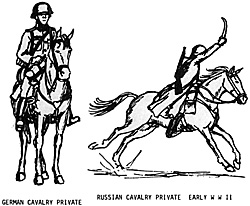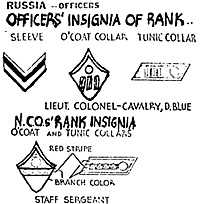
In an excellent series on The Eastern Front in WWII which cropped up in recent issues of Strategy and Tactics, I was surprised to note that reference to that fascinating Russian peculiarity, the horse cavalry division (or Corps for that matter) was brief, inexact, and passing. Since considerable detail was given on other arms the omission was strange. However, it did offer me a chance to dig into a musty file (well, would you believe stacks of envelopes?) marked "To be worked into shape for future issues," and extract some notes on the subject.
Red Army Cavalry
According to these notes, Red Army Cavalry was organized as follows:
Cavalry Division:
3 to 4 horse cavalry regiments, 1 reconnaissance squadron, 1 medium tank battalion (approximately 40-60 T-34's), 1 artillery regiment with 3 X 6 gun batteries of 76mm field guns and 2 batteries of 120mm mortars, 1 battery of light anti-aircraft weapons, 1 engineer squadron, 1 signal squadron, and 1/2 supply squadron. Total manpower was around 6,000 troopers.
Cavalry Regiment
4 saber squadrons w/ 8.1m.g., 6 anti-tank rifles, and a varying proportion of s.m.g. per squadron. 1 machine gun squadron with 16 1.m.g. or m.m.g. 1 76mm field battery, normally of 6 weapons. 1 45mm anti-tank battery. 1 squadron of 12 82mm mortars. 1 light anti-aircraft machine gun troop (6 weapons.) 1 signal troop. 1 poineer troop. 1 chemical warfare troop.
 A similar uniform to the infantry was worn, but with dark blue collar patch and
black piping for the cavalry, raspberry collar patch with black piping for the infantry. The
engineer troops wore flat black collar patches with piping, chemical troops flat black
collar patch with black piping. Tank troops wore a grey tunic and slacks with black velvet
collar patch and red piping, artillery same as chemical.
A similar uniform to the infantry was worn, but with dark blue collar patch and
black piping for the cavalry, raspberry collar patch with black piping for the infantry. The
engineer troops wore flat black collar patches with piping, chemical troops flat black
collar patch with black piping. Tank troops wore a grey tunic and slacks with black velvet
collar patch and red piping, artillery same as chemical.
Red Cavalry Tales
All manner of wild tales of the Red Cavalry came out of World War II. Guderian records (Panzer Leader) that early in the Barbarossa campaign some of his units suffered a momentary check when Russian cavalry struck from the Pripet Marshes, which were regarded as impassible to man or beast, let alone motor troops. He claims to have warned his subordinates that Russian cavalry could go through there but nobody paid any attention. Other commentators have claimed that Russian horses, contrary to popular opinion, had rough going in heavy snow, but didn't seem to mind mud very much.
Some accounts make too much of the cavalry (these appeared often in the U.S. Cavalry Journal, whose horse starved readers seem to have regarded the Cossacks with no little envy.) Other tales suggest that after initial successes the Red Cavalry were quickly subdued by well trained German machine gunners. However, as the numbers of cavalry and the size of cavalry masses rose in Russia, and the Germans raised their own horse cavalry in increasing numbers, it would appear that the well trained German machine gunners didn't always get their message across.
It was claimed for the cossacks, presumably on both sides, that they could disappear, man and horse, into short grass with the speed of a foot-soldier jumping into a shell hole. Depending on the particular rumor you want to base your rules on, Eastern Front cavalry can be anything from hopeless canonfodder to invincible.
In actual fact, however, cavalry in World War II was neither. Occasionally caught in the open, like the Polish troopers, they fared badly. Charging in open order behind masses of T-34's they could be very dangerous to people who kept their heads down too long to let the tanks pass, and even more so to those who scattered in terror. Faster than infantry, and quieter and more flexible than motor troops, horsemen excelled in partisan hunting, partisan warfare generally, hit and run raids, and rough country reconnaissance work. Dismounted, with the horses off to the rear, there was little to distinguish a rifleman or submachine gunner of cavalry from dismounted marching, motor, or panzer infantry.
German Cavalry
The German Cavalry, on the other hand, was more heavily armed. Dr. Bernard Fall, who was killed in the current Vietnam War by a mine, did an article for Revue Historique de I'Armee in 1955 which identified four basic types of large cavalry formations in the Third Reich:
Wehrmacht
At the start of the war the 1st Cavalry didision consisted of 4 horse regiments and an artillery regiment. It served creditably in Poland, Holland, and was credited in dispatches with destroying 35 of 40 French tanks which attacked it.
In common with the later Waffen SS Cavalry the 1st seems to have had the following:
10,000 men, 8,200 horses
1 mounted M.G. Company
1 mounted rocket company (SS only)
1 horse artillery regiment of:
Headquarters
2 105mm howitzer groups with a total of 32 weapons
1 150mm howitzer group with 6 weapons
26 x 20mm AA guns
16 x 37mm AA guns
36 x 75mm or 88mm AA gun
1 motorized anti-
tank squadron
1 motorcycle or bicycle squadron
Signal and Engineer
Battalion (party motorized)
1 partly motorized supply regiment.
The Wehrmacht cavalry schools closed down early in the war and only 1 division of cavalry, which converted to Panzer in 1942 saw action. However, Guderian relates that the horses were turned over to the mounted reconnaissance units of the infantry divisions on the Eastern Front.
SS and SA Mounted
A second category consisted of pre-war SS and SA mounted units. However, the SS detachments included, these were mostly for show, are not known to have seen action, even though many continued during the war years, and, thoroughly non- combattant that the Nuremburg Tribunal was unable to find them guilty of anything!
After the invasion of Russia, however, the Waffen SS raised a 1st and later a 22nd Cavalry Division. These were fairly similar in structure to the old Wehrmacht Cavalry Division, but had mounted rocket units, presumably horse nebelwerfers. To be on the safe side, you might drop these out, since they were described with an unfamiliar French word.
Raised later, the SS units also had about 30% submachine guns, and each regiment had 215 light machine guns, 42 heavy machine guns, 30 81mm mortars, and 4 captured Russian 120mm mortars.
SS Cossack Division
This was also raised by the SS, consisting of 3 brigades of 2 regiments each, with 1 cycle squadron per brigade, and 1 mounted m.g. company per squadron. (4 squadrons per regiment?) The cossacks also had the regimental unit of "engines montee," whatever that is.
So successful did the SS Cossack Cavalry prove in combat that in 1944 two more divisions were added to make up the 15th SS Cossack Cavalry Corps. The greater part of this force fought its way to the west and surrendered to the British at the end of the war. SS Cossack troops were not tried at Nuremburg so far as I know. Probably they were forcibly "re-patriated," a Soviet process of re-indoctrination after re-patriation usually made trial unnecessary, and while less genteel than Hitler's "final solution," was no less dangerous to the recipient.
Back to The Armchair General Vol. 2 No. 8 Table of Contents
Back to The Armchair General List of Issues
Back to MagWeb Master Magazine List
© Copyright 1970 by Pat Condray
This article appears in MagWeb (Magazine Web) on the Internet World Wide Web. Other military history articles and gaming articles are available at http://www.magweb.com
